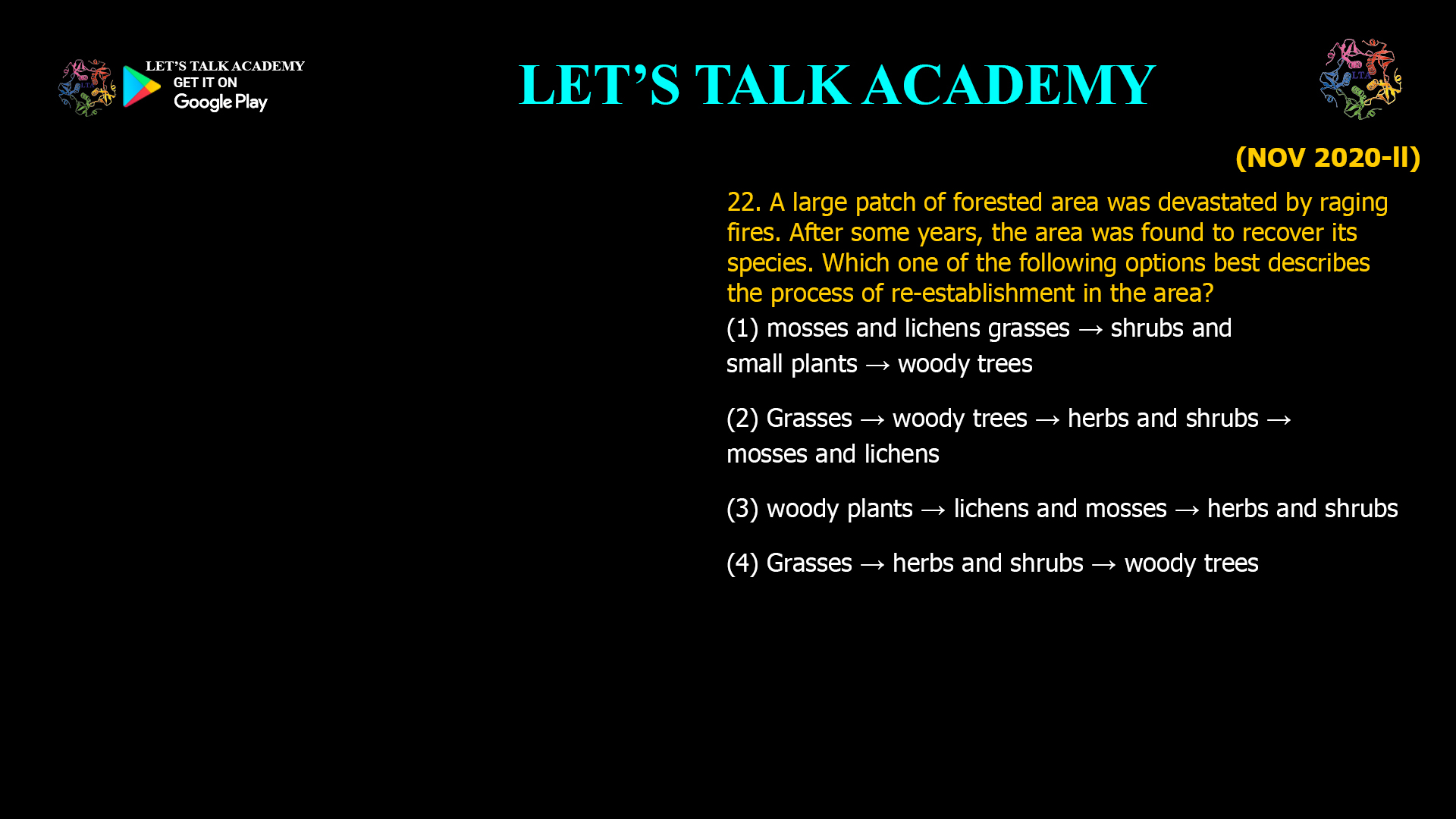- A large patch of forested area was devastated by raging fires. After some years, the area was found to recover its species. Which one of the following options best describes the process of re-establishment in the area?
(1) mosses and lichens grasses → shrubs and small plants → woody trees
(2) Grasses → woody trees → herbs and shrubs → mosses and lichens
(3) woody plants → lichens and mosses → herbs and shrubs
(4) Grasses → herbs and shrubs → woody treesIntroduction
Forests are dynamic ecosystems that can recover remarkably after disturbances such as fires. When a large patch of forest is devastated by fire, the process of re-establishment is known as secondary succession. Understanding this process is essential for ecologists, conservationists, and land managers who work to restore and protect forested landscapes. This article explores the question: Which sequence best describes the process of re-establishment in a forested area after a fire? By examining the options and explaining the stages of secondary succession, we clarify the correct answer and provide a comprehensive overview of forest recovery.
What Is Secondary Succession?
Secondary succession is the process by which a biological community re-establishes itself after a disturbance that does not destroy the soil or all living organisms. In the case of a forest fire, the soil remains intact, and some seeds, roots, and organic matter survive, allowing vegetation to recover relatively quickly compared to primary succession (which occurs on bare rock or newly formed land).
Stages of Forest Recovery After Fire
After a fire, the forest goes through several stages as it recovers:
1. Grasses and Herbaceous Plants
Grasses and other herbaceous plants are usually the first to colonize the burned area. These species are fast-growing, have seeds that can survive in the soil, and are well-adapted to open, sunny conditions. They quickly cover the ground, helping to stabilize the soil and prevent erosion.
2. Herbs and Shrubs
As the grasses establish, herbs and shrubs begin to grow. These plants are taller and provide more structure to the recovering ecosystem. They may include species that were present before the fire or new arrivals that take advantage of the open conditions.
3. Woody Trees
Over time, woody trees start to dominate the area. These trees are often shade-tolerant and grow more slowly than the initial colonizers. As the forest canopy closes, the environment becomes less suitable for grasses and shrubs, and the community shifts toward a mature forest.
Why Mosses and Lichens Are Not the First Colonizers
Mosses and lichens are typically the first colonizers in primary succession, where there is no soil (such as after a volcanic eruption or glacier retreat). In secondary succession after a fire, the soil and some plant material remain, so mosses and lichens are not usually the first to appear. Instead, grasses and herbaceous plants take advantage of the existing soil and available sunlight.
Comparing the Options
Let’s examine the options provided:
-
Mosses and lichens → grasses → shrubs and small plants → woody trees
-
This sequence describes primary succession, not secondary succession after a fire.
-
-
Grasses → woody trees → herbs and shrubs → mosses and lichens
-
This sequence is incorrect because woody trees do not appear before herbs and shrubs, and mosses and lichens are not typical of late-stage forest recovery.
-
-
Woody plants → lichens and mosses → herbs and shrubs
-
This sequence is incorrect and does not reflect any known succession process.
-
-
Grasses → herbs and shrubs → woody trees
-
This sequence correctly describes secondary succession after a fire.
-
The Importance of Secondary Succession
Understanding secondary succession is crucial for managing and restoring forests after disturbances. By recognizing the stages of recovery, land managers can implement strategies to support natural regeneration, control invasive species, and promote biodiversity.
Common Misconceptions
A common misconception is that mosses and lichens are the first to colonize after all types of disturbances. In reality, mosses and lichens are pioneers in primary succession, where there is no soil. After a fire in a forested area (secondary succession), grasses and herbaceous plants are the first to appear.
Another misconception is that woody trees appear immediately after a fire. In fact, woody trees are usually the last to dominate, as they require more time to grow and establish.
Conclusion
The correct sequence for the re-establishment of a forested area after a fire is:
Grasses → herbs and shrubs → woody trees
This sequence reflects the process of secondary succession, in which the soil and some plant material remain, allowing for rapid and predictable recovery. By understanding these stages, we can better manage and protect our forests for future generations.
-




7 Comments
Kirti Agarwal
October 21, 2025After fire or secondary succession grass, herbs oe shrubs, woody trees
Santosh Saini
October 26, 2025When a large patch of forest is devastated by fire, the process of re- establishment is known as secondary succession…, Grasse→ herbs and shrubs →woody trees ( this sequence correctly describes secondary succession after a fire
Prena Ghangas
October 29, 2025Grasses → herbs and shrubs → woody trees
Kajal
October 31, 2025This is secondary succession so option 4is correct
Kavita Choudhary
November 11, 2025Grass
hurbs and shurb
Woody trees
Sakshi Kanwar
November 27, 2025Grasses → herbs and shrubs → woody trees
This sequence reflects the process of secondary succession
Neelam Sharma
November 28, 2025Grasses → herbs and shrubs → woody trees